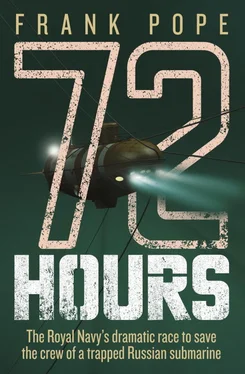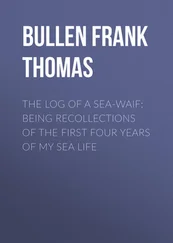As Macintyre levelled the Globemaster off on a heading for their first waypoint above Norway, the second crew settled into their off shift. They’d each be spending two hours in the single bunk, keeping themselves as fresh as possible for the long flight over. They’d need every minute of rest they could get. Unbeknown to them, the first tendrils of cloud were beginning to gather around the sharp volcanic peaks that guard the approaches to the runways of Elizovo airport, and the Instrument Landing System at the airport that they were banking on was out of action.
Friday, 5 August/Saturday, 6 August
SS + 40 h 30 mins
21.00 UK – 00.00 Moscow – 09.00 Kamchatka
Petropavlosk-Kamchatsky
Watching the television news on the Rossiya channel in her sister’s flat in Zavoyko, Yelena Milachevsky jerked herself upright. Pacific Fleet Commander Viktor Fyodorov appeared from his head quarters in Vladivostok to announce that AS-28 was being towed to shallower waters, where divers would be able to disentangle any remaining nets and cables. ‘We have hooked on a cable,’ he said. ‘Our ships are raising and towing the submersible to shallow waters. We will carry out this task using our own resources and will raise (the submersible) to the surface.’
Yelena called the headquarters to find out more, and was told that her husband’s craft had been towed for 30 metres. An hour and a half later, the Navy announced that it had managed to raise the temperature inside the submersible to ten degrees. But when Yelena called Slava’s father, her hopes started to wither once more. Why, Vladimir Valentinovich Milachevsky asked, if they’d managed to tow the Priz at all, did they not tow it all the way to the surface? And how were they increasing the temperature inside? Milachevsky senior could think of no mechanism with which this could be done.
He was right to be suspicious. On the Kursk , the last surviving sailors had survived for ten long hours after the initial explosion that had sent the submarine crashing to the sea floor. Unable to reach the wreckage because of repeated failures of both procedures and equipment, the Russian rescue teams had not known what the situation on board was, but a full three days and ten hours later, official sources were still saying they could hear tapping from the hull, and that there was enough oxygen on board for another five to six days.
Igor Dygalo, the aide to the head of the Russian Navy, whose wildly varying estimates of the breathable air remaining on AS-28 had so spooked Yelena earlier in the day, had also been among those releasing information during the unfolding Kursk scandal. Four days into that drama, he’d claimed that Kursk had settled at a severe angle on hitting the seabed, while terrible visibility and strong currents were hampering rescue attempts on the sea bottom. The international rescue effort, including Commodore David Russell, who had led the UK’s team, had heard the announcement and fretted. Those conditions – particularly the angle at which Dygalo said she lay – would confound anybody’s technology. But some with experience of the Barents Sea were suspicious: the shallow shelf seas that dominated the region rarely felt currents as strong as were being claimed. They were right. When Norwegian divers were finally allowed to reach the site, they found the conditions benign and – what’s more – the submarine was only listing at a very manageable four degrees.
Guzel Latypova had already paid a visit to Yelena that morning, sitting with her and discussing the situation with her and her family as it developed. Latypova kept a special ear open when Yelena’s friend at the Naval headquarters rang. This, she’d realised, was a far more regular and reliable source of information than the official press statements. Every half-hour or so, Latypova would discreetly file a short update to Interfax .
Friday, 5 August/Saturday, 6 August
SS + 42 h
14.30 San Diego – 22.30 UK – 01.30 Moscow – 10.30 Kamchatka
Naval Air Station North Island, San Diego, California
Commander Kent Van Horn was tearing his hair out. Despite all the drills he’d put his men through in the past nine months to speed up the loading process, things were moving like cold treacle. There was a C5 sitting on the apron at North Island, but they weren’t being allowed to use it, and it had taken until four in the morning to get even an ETA for a replacement aircraft. His men were ready and waiting, but they were being held up by other elements.
He had all crews and equipment standing by ready to load the moment that the C5 arrived. The short journey across the airport had been one of Van Horn’s concerns when looking out for trouble spots where his unit might lose time in loading. Since they were reliant on trucks that weren’t under their direct command, there was a chance that they would be delayed by other obligations. To cut out that risk, Van Horn had installed wheel systems on the bottom of his equipment containers, so that the Deep Submergence Unit’s pickup trucks could tow them over to the loading area if the usual heavy-hauling trucks didn’t show up in time. But he’d had hours to get his equipment in place while waiting for the aircraft to arrive from Travis Airbase, outside San Francisco. It hadn’t got there until 12.30 Pacific Time.
When the loadmasters emerged from the C5 they had bad news. The tail-section door was not functioning properly, and they would only be able to load through the nose of the aircraft. Although that was just as big as the aft doors, using only one end was going to slow them down. Van Horn gritted his teeth. The C5s had been around since 1968, and though the type had been through some major refits – including new sets of wings in the 1980s – they were still notoriously temperamental.
A Reliability Enhancement and Re Engining Program (RERP) was being planned, but for now the C5 crews knew their aircraft by another acronym, FRED, standing for ‘F***ing Ridiculous Economic/Environmental Disaster’. On top of its enormous fuel consumption, for every hour of flight the C5 required an average 16 hours of maintenance. Some of Van Horn’s precious cargo space was occupied by entire pallets full of spares for the aircraft, forcing the DSU to break apart some of their carefully pre-packed pallets and store them loose in order to get them on board. Once again, Van Horn’s carefully rehearsed drills were going out the window. First the plane was late, now the loading was taking far longer than it should.
An hour before takeoff the C5 was the only aircraft that was scheduled to be making the trip, but the US response was escalating. Other elements of the Navy had become convinced that Atmospheric Diving Suits (ADSs) were a better bet than an ROV in this situation. Because they carried a human operator they only required a crane to put them in the water and recover them, rather than the additional complexity of running umbilical cables and installing a command cabin on board a foreign ship. This simplicity meant they could be airlifted straight from the airbase out to the ships that were on site, potentially saving many valuable hours. Preparations began to send a second aircraft, a C17 Globemaster, with two ADS suits.
After all the delays, it wasn’t until 14.22 Pacific Time that the C5 began rolling down the taxiway, and it finally lifted off eight minutes later. According to his first projection of the US team’s Time to First Rescue, his Super-Scorpio ROV should be tapping against the side of the trapped submersible in just ten hours’ time. But now he suspected they’d still be in the air, and would certainly not have offloaded, been transported to the vessel, then have loaded, set up and steamed into position over the incident site. Even with the 31 enlisted men, six officers and three civilian dive contractors he had on board, he’d be pushed to make it in even 16 hours.
Читать дальше












